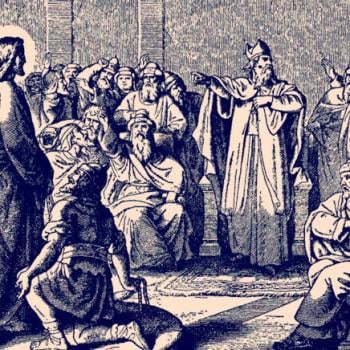 On Friday of this past week, I spent the day with our Student Ministry team on a one-day retreat. In Student Ministry style we met for the day at Game Works, a Video Game Restaurant. We used a conference room there for the day.
On Friday of this past week, I spent the day with our Student Ministry team on a one-day retreat. In Student Ministry style we met for the day at Game Works, a Video Game Restaurant. We used a conference room there for the day.
The SM team at our church are great guys: Eric Ferris, Pete Sutton, Jameson Ross, Bobby Jackson, Andy Klenke, and Eric Chesney. Eric Ferris is the Student Ministry director; Pete is the Middle School pastor; Jameson is the High School pastor; Andy and Eric C. are extension campus student pastors; and I am the college pastor. Our task for the day was to present and discuss curriculum. The question of the day was simply
“What should we be teaching students from sixth grade through college?”
As we discovered this is a difficult question and many issues surfaced:
- Should life-stage issues provide the lens through which we teach doctrine and the Bible?
- Should we do cetechesis in some form?
- Of all the doctrines of the church and Bible books and passages we could teach, what is most essential?
- Should we have a one- two- or three- year teaching plan?
I have no firm or certain answers to these questions. I do however have some opinion on what the center of our teaching should be and what should be the guiding criterion for determining what should be taught. I do have some opinion about how the Bible should be, or better, should not be used. And I have an opinion about what would be ideal.
(1) I believe that Christology should be at the center of our teaching.
All of us around the table that day would affirm the need to present the Gospel regularly in and through our teaching. But this simply means that the plan of salvation is presented regularly. That students “know” how to be saved. But that’s not really what I mean by having Jesus at the center. I believe you can give the plan of salvation regularly, and not have Jesus at the center of your teaching. What I mean is that Jesus, pure and simple, should be presented constantly. Our teaching should be saturated with Jesus. We should be telling stories about Jesus. We should be talking about Jesus teachings. We should be presenting Jesus’ character. We should be discussing Jesus’ death and resurrection. We should be teaching about this second-coming to judge. Christology should be the center and serve as the central criterion for all our teaching. I don’t think we can teach too much of Jesus. Some might protest and say that students will become bored if all we discuss is Jesus. I think that has more to do with the how than the what.
(2) I believe that we should not just teach Jesus haphazardly or selectively.
We should teach our students a Gospel. They should know at least one Gospel story inside and out – and if possible more. Not a truncated, externally pieced together set of ideas about Jesus. But actually an authorized story of Jesus, one of the Four Gospels. Students should know the gospel according to Matthew, Mark, Luke and John. Or at least one or two of them by the end of their Student Ministry years. I believe students think they know a lot about Jesus and the gospel. But truth be told, they don’t know intimately a New Testament Gospel. I deal with College students all the time who grew up in youth ministries who know fragments, but have not been taught a whole Jesus. How much do we teach Jesus? How much do we teach the Gospel – again this is not a reference to the plan of salvation.
Here’s a suggestion: Each segment of the SM takes a Gospel and its their job to instill that Gospel into the students. I would suggest this plan:
- Middle School : Mark
- High School : John
- College : Luke or Matthew
(3) I believe that we must be more careful about how we use the Bible to teach students.
I think the criticism Christian Smith levels in his book The Bible Made Impossible needs to be taken seriously by Student Ministry. Smith doesn’t address this segment of the population in his critique of Biblicism (I’d actually like to hear him address this since he’s the expert on Youth in America), but in evangelical youth ministries everywhere the Bible is used as a “handbook” for life – the Bible’s teaching on sex and dating, career choice, money, suicide, sports, and friendships just to name a few. If you look at Student Bible’s today they are even designed to present the Bible as a handbook. “Struggling with . . .” ; “Look at these Bible passages”. While I would not want to say that God’s Word has nothing to say to these issues, I believe it does if implicitly, I believe the approach to the Bible is inappropriate. The Bible is centrally interested in telling its readers about God’s Story. The Old Testament focuses on the Story of Israel. The New Testament Gospels focus on Israel’s Story coming to its fulfillment in the story of Jesus. The rest of the New Testament documents represent the earliest stage of disciples both Jews and Gentiles finding their own identities within that Story. We would do well to see our role as teachers of students primarily a work of identity formation.
(4) It is important to recognize that not all parts of the Bible are as essential as some other parts.
While it is all inspired, not all is essential – at least for Gentile Christian students. We would do well to take time to think about which parts of the Bible are the most important and focus on those, and this is particularly important in teaching from the Old Testament. More than a half-century ago C. H. Dodd made the argument that the early Christians created what you could call a “canon within a canon”. Dodd called it the Testimonia in his book According to the Scriptures. He made the argument that the earliest Christians had a selection of OT texts from which they drew. Here’s the list:
Genesis 12:3; 22:18; Deut 18:15-19; 2 Sam 7:13; Isa 6:1-9:7; 11:1-10; 28:16; 29:9-14; 40:1-11; 42:1-44:5; 49:1-13; 50:4-11; 52:13-53:12; 55:3; 58:6-10; 61; Jeremiah 7:1-15; 31:1-34; Joel 2-3; Amos 9:11-12; Habakkuk 1-2; Zechariah 9-14; Malachi 3:1-6; Psalm 2; 8; 22; 31; 34; 38; 42; 43; 69; 80; 88; 110; 118; 132; Daniel 7; 12.
It was these texts, he argued, that formed the substructure of New Testament apostolic preaching and teaching. As an example of selectivity, I think it would be wise to focus on just such a selection of OT texts in a SM curriculum. Students should know the scriptural foundations of Apostolic faith.















